Strategic Leadership and HRM Practices Report for Toyota Company
VerifiedAdded on 2022/08/26
|33
|9020
|17
Report
AI Summary
This report examines strategic leadership and human resource management (HRM) practices within Toyota, aiming to identify how effective strategies contribute to organizational success. The introduction provides a company profile, outlining Toyota's mission, vision, and global presence, alongside the aims and objectives of the study, and its contextual relevance. A literature review explores strategic HRM's impact on organizational performance, focusing on topics such as employee development, talent management, and stakeholder integration. The report then applies this knowledge to the case study of Toyota, analyzing current HRM practices and identifying potential issues. A change implementation plan is proposed, including the application of Kotter’s and Lewin’s change management models, forecasting human capital demand, stakeholder analysis, and communication strategies. The report concludes with recommendations for Toyota and a summary of key findings, highlighting the importance of strategic HRM in achieving organizational goals and maintaining a competitive edge in the global automobile market. The report emphasizes employee satisfaction, innovation, and the retention of skilled workforce as key drivers of success.
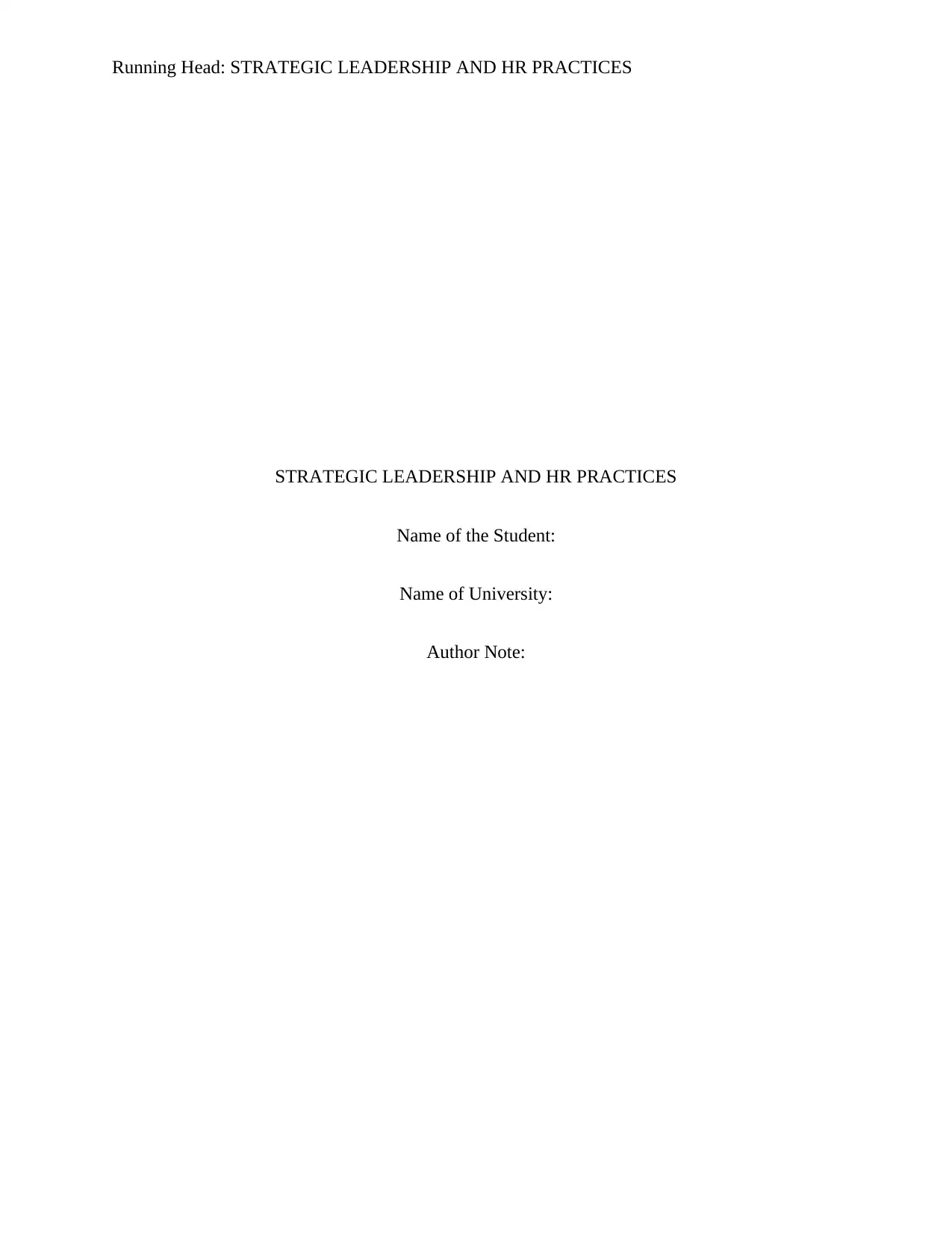
Running Head: STRATEGIC LEADERSHIP AND HR PRACTICES
STRATEGIC LEADERSHIP AND HR PRACTICES
Name of the Student:
Name of University:
Author Note:
STRATEGIC LEADERSHIP AND HR PRACTICES
Name of the Student:
Name of University:
Author Note:
Paraphrase This Document
Need a fresh take? Get an instant paraphrase of this document with our AI Paraphraser
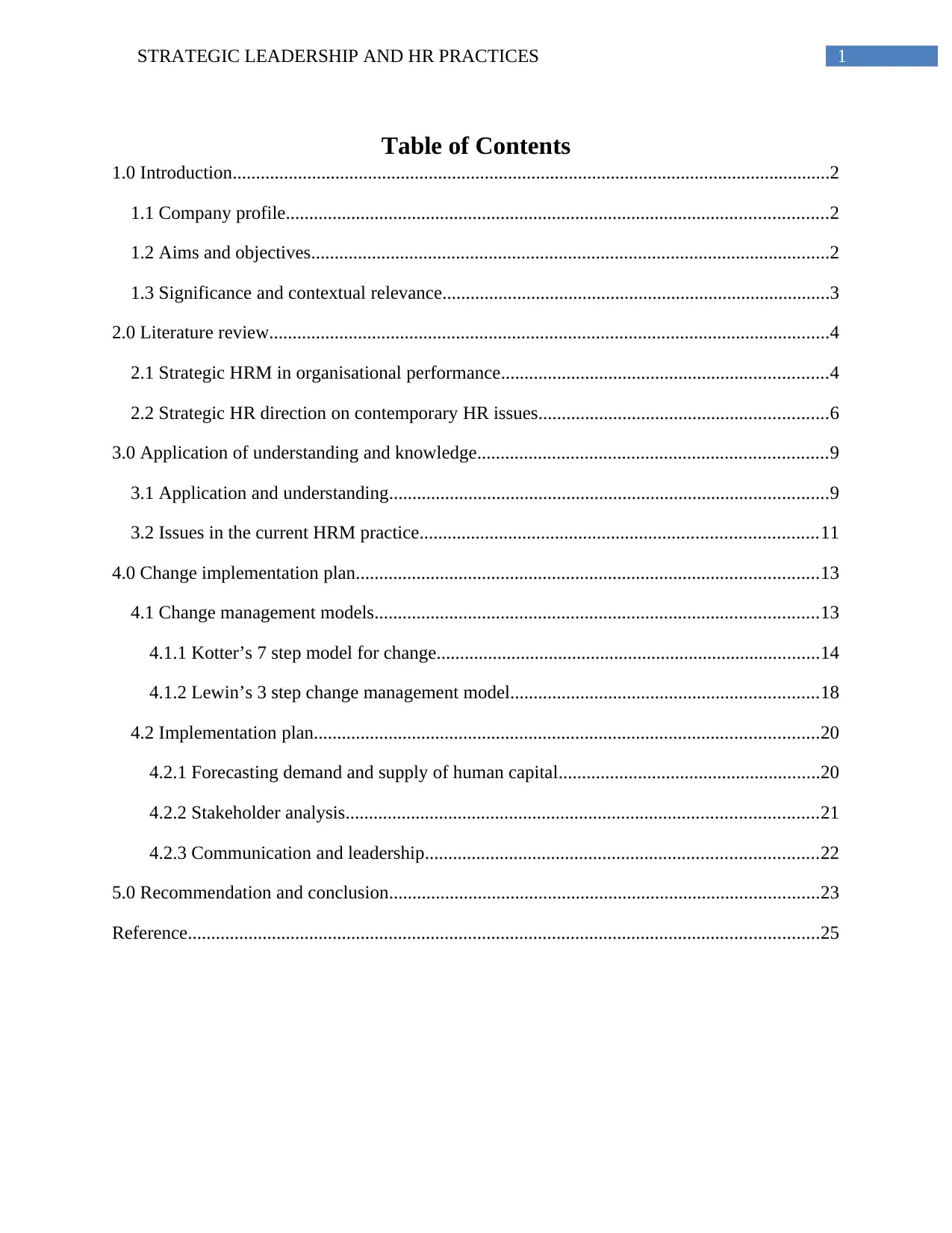
1STRATEGIC LEADERSHIP AND HR PRACTICES
Table of Contents
1.0 Introduction................................................................................................................................2
1.1 Company profile....................................................................................................................2
1.2 Aims and objectives...............................................................................................................2
1.3 Significance and contextual relevance...................................................................................3
2.0 Literature review........................................................................................................................4
2.1 Strategic HRM in organisational performance......................................................................4
2.2 Strategic HR direction on contemporary HR issues..............................................................6
3.0 Application of understanding and knowledge...........................................................................9
3.1 Application and understanding..............................................................................................9
3.2 Issues in the current HRM practice.....................................................................................11
4.0 Change implementation plan...................................................................................................13
4.1 Change management models...............................................................................................13
4.1.1 Kotter’s 7 step model for change..................................................................................14
4.1.2 Lewin’s 3 step change management model..................................................................18
4.2 Implementation plan............................................................................................................20
4.2.1 Forecasting demand and supply of human capital........................................................20
4.2.2 Stakeholder analysis.....................................................................................................21
4.2.3 Communication and leadership....................................................................................22
5.0 Recommendation and conclusion............................................................................................23
Reference.......................................................................................................................................25
Table of Contents
1.0 Introduction................................................................................................................................2
1.1 Company profile....................................................................................................................2
1.2 Aims and objectives...............................................................................................................2
1.3 Significance and contextual relevance...................................................................................3
2.0 Literature review........................................................................................................................4
2.1 Strategic HRM in organisational performance......................................................................4
2.2 Strategic HR direction on contemporary HR issues..............................................................6
3.0 Application of understanding and knowledge...........................................................................9
3.1 Application and understanding..............................................................................................9
3.2 Issues in the current HRM practice.....................................................................................11
4.0 Change implementation plan...................................................................................................13
4.1 Change management models...............................................................................................13
4.1.1 Kotter’s 7 step model for change..................................................................................14
4.1.2 Lewin’s 3 step change management model..................................................................18
4.2 Implementation plan............................................................................................................20
4.2.1 Forecasting demand and supply of human capital........................................................20
4.2.2 Stakeholder analysis.....................................................................................................21
4.2.3 Communication and leadership....................................................................................22
5.0 Recommendation and conclusion............................................................................................23
Reference.......................................................................................................................................25
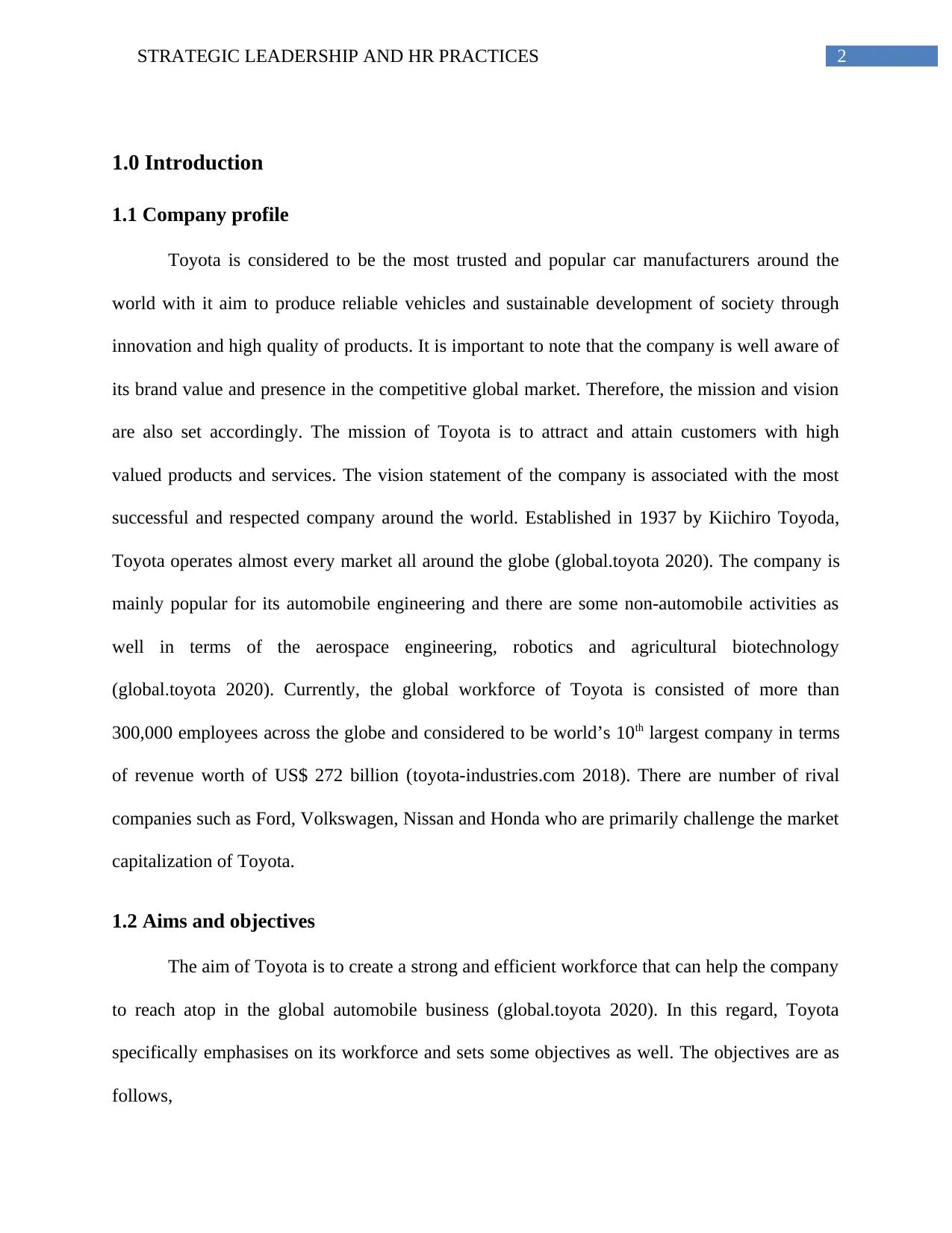
2STRATEGIC LEADERSHIP AND HR PRACTICES
1.0 Introduction
1.1 Company profile
Toyota is considered to be the most trusted and popular car manufacturers around the
world with it aim to produce reliable vehicles and sustainable development of society through
innovation and high quality of products. It is important to note that the company is well aware of
its brand value and presence in the competitive global market. Therefore, the mission and vision
are also set accordingly. The mission of Toyota is to attract and attain customers with high
valued products and services. The vision statement of the company is associated with the most
successful and respected company around the world. Established in 1937 by Kiichiro Toyoda,
Toyota operates almost every market all around the globe (global.toyota 2020). The company is
mainly popular for its automobile engineering and there are some non-automobile activities as
well in terms of the aerospace engineering, robotics and agricultural biotechnology
(global.toyota 2020). Currently, the global workforce of Toyota is consisted of more than
300,000 employees across the globe and considered to be world’s 10th largest company in terms
of revenue worth of US$ 272 billion (toyota-industries.com 2018). There are number of rival
companies such as Ford, Volkswagen, Nissan and Honda who are primarily challenge the market
capitalization of Toyota.
1.2 Aims and objectives
The aim of Toyota is to create a strong and efficient workforce that can help the company
to reach atop in the global automobile business (global.toyota 2020). In this regard, Toyota
specifically emphasises on its workforce and sets some objectives as well. The objectives are as
follows,
1.0 Introduction
1.1 Company profile
Toyota is considered to be the most trusted and popular car manufacturers around the
world with it aim to produce reliable vehicles and sustainable development of society through
innovation and high quality of products. It is important to note that the company is well aware of
its brand value and presence in the competitive global market. Therefore, the mission and vision
are also set accordingly. The mission of Toyota is to attract and attain customers with high
valued products and services. The vision statement of the company is associated with the most
successful and respected company around the world. Established in 1937 by Kiichiro Toyoda,
Toyota operates almost every market all around the globe (global.toyota 2020). The company is
mainly popular for its automobile engineering and there are some non-automobile activities as
well in terms of the aerospace engineering, robotics and agricultural biotechnology
(global.toyota 2020). Currently, the global workforce of Toyota is consisted of more than
300,000 employees across the globe and considered to be world’s 10th largest company in terms
of revenue worth of US$ 272 billion (toyota-industries.com 2018). There are number of rival
companies such as Ford, Volkswagen, Nissan and Honda who are primarily challenge the market
capitalization of Toyota.
1.2 Aims and objectives
The aim of Toyota is to create a strong and efficient workforce that can help the company
to reach atop in the global automobile business (global.toyota 2020). In this regard, Toyota
specifically emphasises on its workforce and sets some objectives as well. The objectives are as
follows,
⊘ This is a preview!⊘
Do you want full access?
Subscribe today to unlock all pages.

Trusted by 1+ million students worldwide
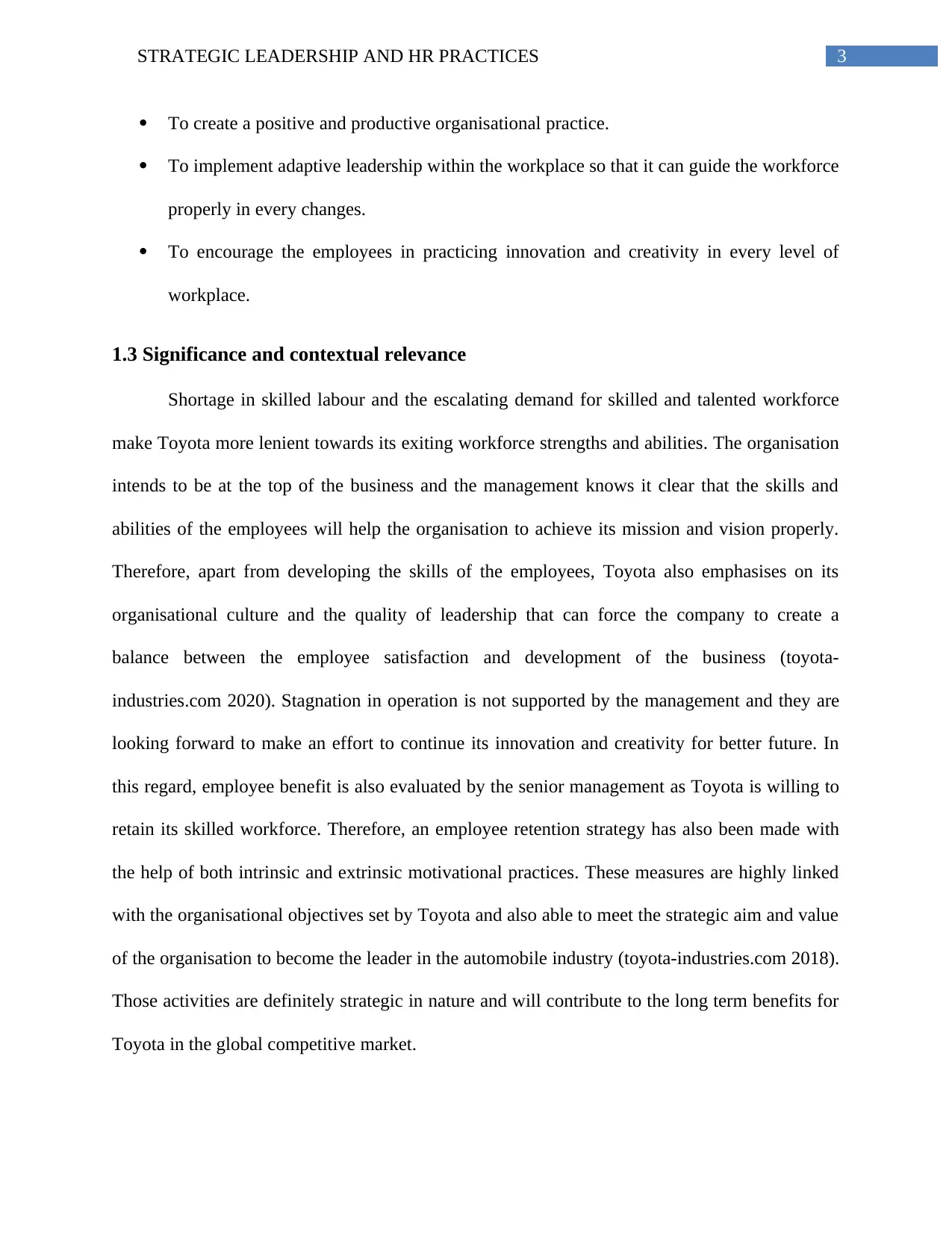
3STRATEGIC LEADERSHIP AND HR PRACTICES
To create a positive and productive organisational practice.
To implement adaptive leadership within the workplace so that it can guide the workforce
properly in every changes.
To encourage the employees in practicing innovation and creativity in every level of
workplace.
1.3 Significance and contextual relevance
Shortage in skilled labour and the escalating demand for skilled and talented workforce
make Toyota more lenient towards its exiting workforce strengths and abilities. The organisation
intends to be at the top of the business and the management knows it clear that the skills and
abilities of the employees will help the organisation to achieve its mission and vision properly.
Therefore, apart from developing the skills of the employees, Toyota also emphasises on its
organisational culture and the quality of leadership that can force the company to create a
balance between the employee satisfaction and development of the business (toyota-
industries.com 2020). Stagnation in operation is not supported by the management and they are
looking forward to make an effort to continue its innovation and creativity for better future. In
this regard, employee benefit is also evaluated by the senior management as Toyota is willing to
retain its skilled workforce. Therefore, an employee retention strategy has also been made with
the help of both intrinsic and extrinsic motivational practices. These measures are highly linked
with the organisational objectives set by Toyota and also able to meet the strategic aim and value
of the organisation to become the leader in the automobile industry (toyota-industries.com 2018).
Those activities are definitely strategic in nature and will contribute to the long term benefits for
Toyota in the global competitive market.
To create a positive and productive organisational practice.
To implement adaptive leadership within the workplace so that it can guide the workforce
properly in every changes.
To encourage the employees in practicing innovation and creativity in every level of
workplace.
1.3 Significance and contextual relevance
Shortage in skilled labour and the escalating demand for skilled and talented workforce
make Toyota more lenient towards its exiting workforce strengths and abilities. The organisation
intends to be at the top of the business and the management knows it clear that the skills and
abilities of the employees will help the organisation to achieve its mission and vision properly.
Therefore, apart from developing the skills of the employees, Toyota also emphasises on its
organisational culture and the quality of leadership that can force the company to create a
balance between the employee satisfaction and development of the business (toyota-
industries.com 2020). Stagnation in operation is not supported by the management and they are
looking forward to make an effort to continue its innovation and creativity for better future. In
this regard, employee benefit is also evaluated by the senior management as Toyota is willing to
retain its skilled workforce. Therefore, an employee retention strategy has also been made with
the help of both intrinsic and extrinsic motivational practices. These measures are highly linked
with the organisational objectives set by Toyota and also able to meet the strategic aim and value
of the organisation to become the leader in the automobile industry (toyota-industries.com 2018).
Those activities are definitely strategic in nature and will contribute to the long term benefits for
Toyota in the global competitive market.
Paraphrase This Document
Need a fresh take? Get an instant paraphrase of this document with our AI Paraphraser
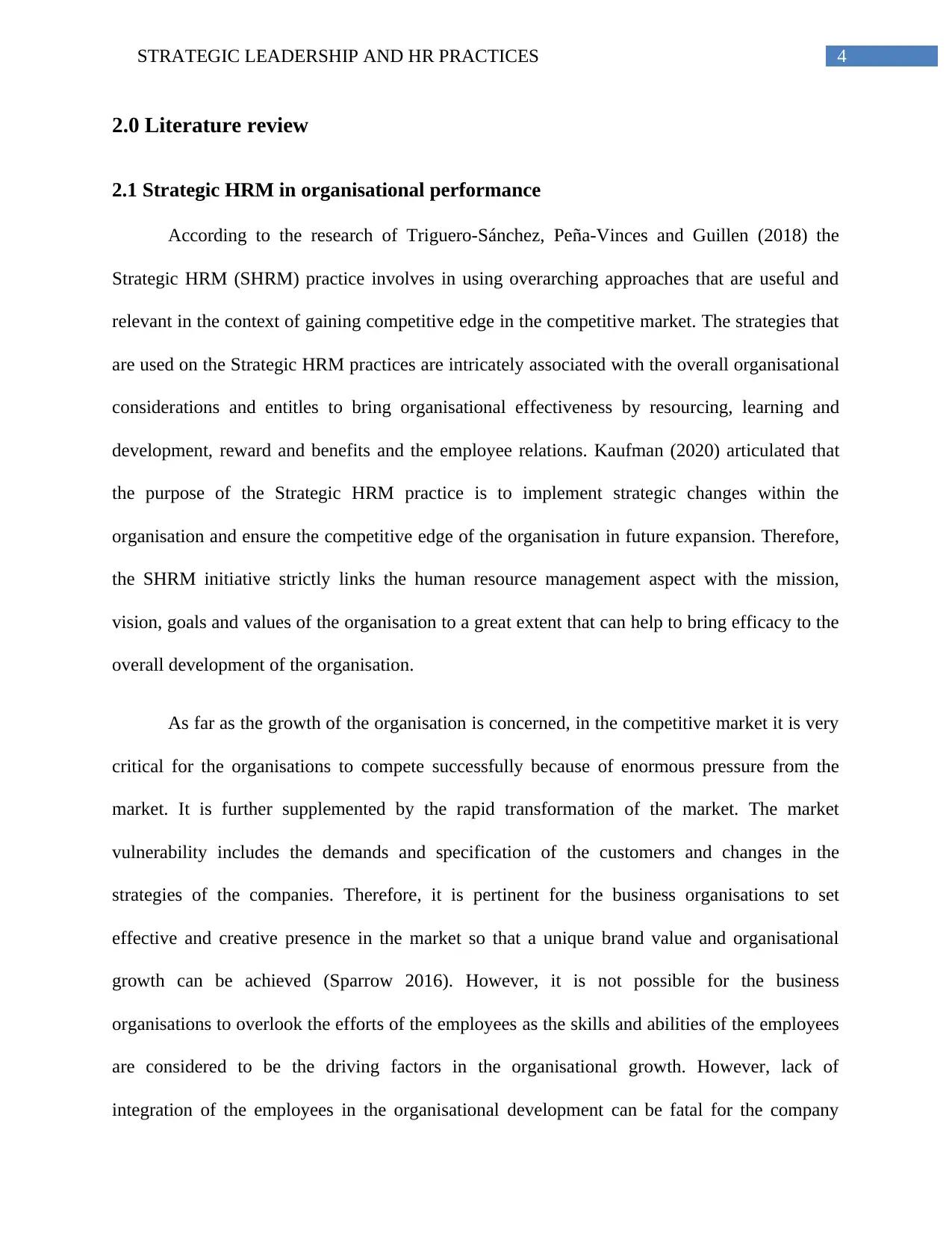
4STRATEGIC LEADERSHIP AND HR PRACTICES
2.0 Literature review
2.1 Strategic HRM in organisational performance
According to the research of Triguero-Sánchez, Peña-Vinces and Guillen (2018) the
Strategic HRM (SHRM) practice involves in using overarching approaches that are useful and
relevant in the context of gaining competitive edge in the competitive market. The strategies that
are used on the Strategic HRM practices are intricately associated with the overall organisational
considerations and entitles to bring organisational effectiveness by resourcing, learning and
development, reward and benefits and the employee relations. Kaufman (2020) articulated that
the purpose of the Strategic HRM practice is to implement strategic changes within the
organisation and ensure the competitive edge of the organisation in future expansion. Therefore,
the SHRM initiative strictly links the human resource management aspect with the mission,
vision, goals and values of the organisation to a great extent that can help to bring efficacy to the
overall development of the organisation.
As far as the growth of the organisation is concerned, in the competitive market it is very
critical for the organisations to compete successfully because of enormous pressure from the
market. It is further supplemented by the rapid transformation of the market. The market
vulnerability includes the demands and specification of the customers and changes in the
strategies of the companies. Therefore, it is pertinent for the business organisations to set
effective and creative presence in the market so that a unique brand value and organisational
growth can be achieved (Sparrow 2016). However, it is not possible for the business
organisations to overlook the efforts of the employees as the skills and abilities of the employees
are considered to be the driving factors in the organisational growth. However, lack of
integration of the employees in the organisational development can be fatal for the company
2.0 Literature review
2.1 Strategic HRM in organisational performance
According to the research of Triguero-Sánchez, Peña-Vinces and Guillen (2018) the
Strategic HRM (SHRM) practice involves in using overarching approaches that are useful and
relevant in the context of gaining competitive edge in the competitive market. The strategies that
are used on the Strategic HRM practices are intricately associated with the overall organisational
considerations and entitles to bring organisational effectiveness by resourcing, learning and
development, reward and benefits and the employee relations. Kaufman (2020) articulated that
the purpose of the Strategic HRM practice is to implement strategic changes within the
organisation and ensure the competitive edge of the organisation in future expansion. Therefore,
the SHRM initiative strictly links the human resource management aspect with the mission,
vision, goals and values of the organisation to a great extent that can help to bring efficacy to the
overall development of the organisation.
As far as the growth of the organisation is concerned, in the competitive market it is very
critical for the organisations to compete successfully because of enormous pressure from the
market. It is further supplemented by the rapid transformation of the market. The market
vulnerability includes the demands and specification of the customers and changes in the
strategies of the companies. Therefore, it is pertinent for the business organisations to set
effective and creative presence in the market so that a unique brand value and organisational
growth can be achieved (Sparrow 2016). However, it is not possible for the business
organisations to overlook the efforts of the employees as the skills and abilities of the employees
are considered to be the driving factors in the organisational growth. However, lack of
integration of the employees in the organisational development can be fatal for the company
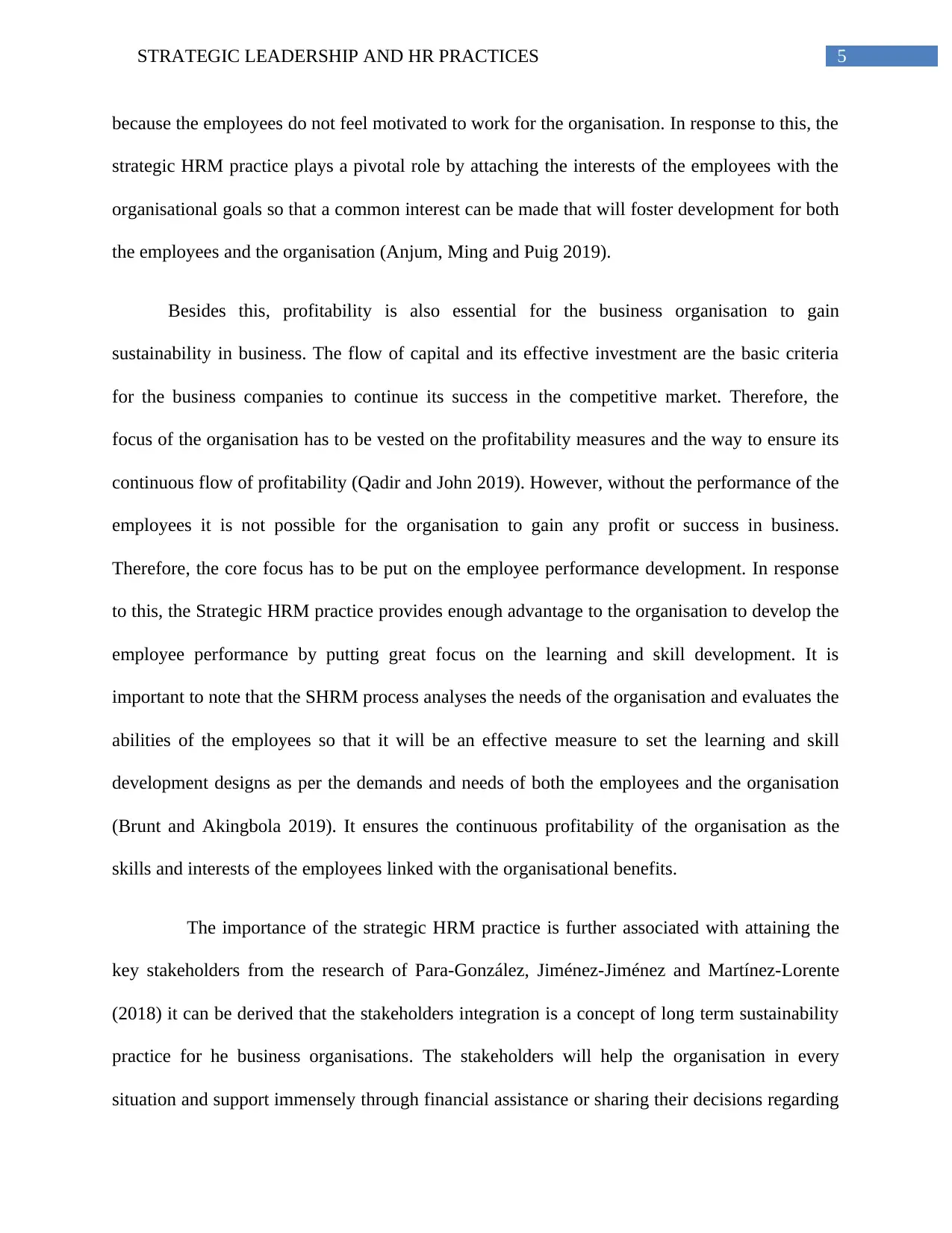
5STRATEGIC LEADERSHIP AND HR PRACTICES
because the employees do not feel motivated to work for the organisation. In response to this, the
strategic HRM practice plays a pivotal role by attaching the interests of the employees with the
organisational goals so that a common interest can be made that will foster development for both
the employees and the organisation (Anjum, Ming and Puig 2019).
Besides this, profitability is also essential for the business organisation to gain
sustainability in business. The flow of capital and its effective investment are the basic criteria
for the business companies to continue its success in the competitive market. Therefore, the
focus of the organisation has to be vested on the profitability measures and the way to ensure its
continuous flow of profitability (Qadir and John 2019). However, without the performance of the
employees it is not possible for the organisation to gain any profit or success in business.
Therefore, the core focus has to be put on the employee performance development. In response
to this, the Strategic HRM practice provides enough advantage to the organisation to develop the
employee performance by putting great focus on the learning and skill development. It is
important to note that the SHRM process analyses the needs of the organisation and evaluates the
abilities of the employees so that it will be an effective measure to set the learning and skill
development designs as per the demands and needs of both the employees and the organisation
(Brunt and Akingbola 2019). It ensures the continuous profitability of the organisation as the
skills and interests of the employees linked with the organisational benefits.
The importance of the strategic HRM practice is further associated with attaining the
key stakeholders from the research of Para-González, Jiménez-Jiménez and Martínez-Lorente
(2018) it can be derived that the stakeholders integration is a concept of long term sustainability
practice for he business organisations. The stakeholders will help the organisation in every
situation and support immensely through financial assistance or sharing their decisions regarding
because the employees do not feel motivated to work for the organisation. In response to this, the
strategic HRM practice plays a pivotal role by attaching the interests of the employees with the
organisational goals so that a common interest can be made that will foster development for both
the employees and the organisation (Anjum, Ming and Puig 2019).
Besides this, profitability is also essential for the business organisation to gain
sustainability in business. The flow of capital and its effective investment are the basic criteria
for the business companies to continue its success in the competitive market. Therefore, the
focus of the organisation has to be vested on the profitability measures and the way to ensure its
continuous flow of profitability (Qadir and John 2019). However, without the performance of the
employees it is not possible for the organisation to gain any profit or success in business.
Therefore, the core focus has to be put on the employee performance development. In response
to this, the Strategic HRM practice provides enough advantage to the organisation to develop the
employee performance by putting great focus on the learning and skill development. It is
important to note that the SHRM process analyses the needs of the organisation and evaluates the
abilities of the employees so that it will be an effective measure to set the learning and skill
development designs as per the demands and needs of both the employees and the organisation
(Brunt and Akingbola 2019). It ensures the continuous profitability of the organisation as the
skills and interests of the employees linked with the organisational benefits.
The importance of the strategic HRM practice is further associated with attaining the
key stakeholders from the research of Para-González, Jiménez-Jiménez and Martínez-Lorente
(2018) it can be derived that the stakeholders integration is a concept of long term sustainability
practice for he business organisations. The stakeholders will help the organisation in every
situation and support immensely through financial assistance or sharing their decisions regarding
⊘ This is a preview!⊘
Do you want full access?
Subscribe today to unlock all pages.

Trusted by 1+ million students worldwide
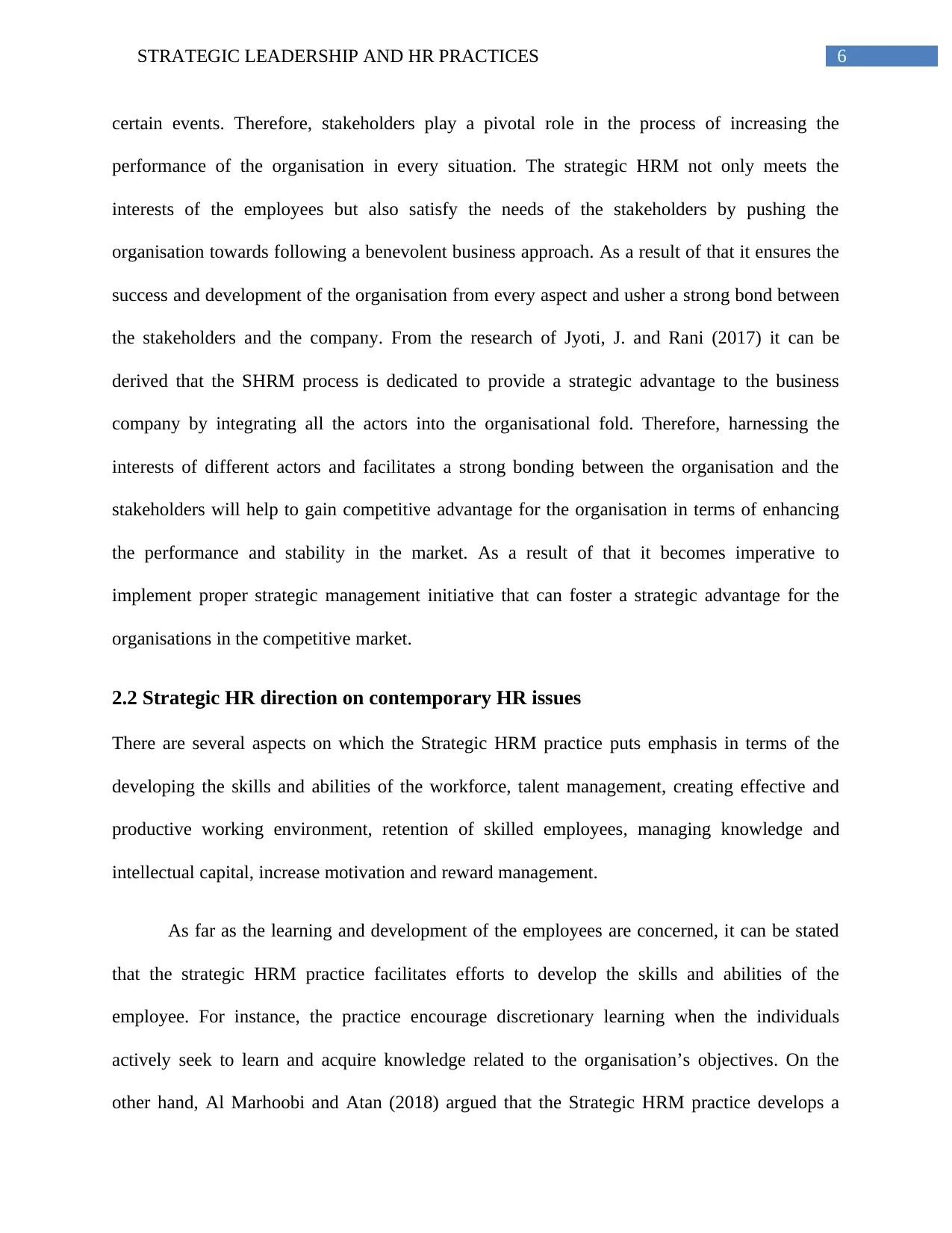
6STRATEGIC LEADERSHIP AND HR PRACTICES
certain events. Therefore, stakeholders play a pivotal role in the process of increasing the
performance of the organisation in every situation. The strategic HRM not only meets the
interests of the employees but also satisfy the needs of the stakeholders by pushing the
organisation towards following a benevolent business approach. As a result of that it ensures the
success and development of the organisation from every aspect and usher a strong bond between
the stakeholders and the company. From the research of Jyoti, J. and Rani (2017) it can be
derived that the SHRM process is dedicated to provide a strategic advantage to the business
company by integrating all the actors into the organisational fold. Therefore, harnessing the
interests of different actors and facilitates a strong bonding between the organisation and the
stakeholders will help to gain competitive advantage for the organisation in terms of enhancing
the performance and stability in the market. As a result of that it becomes imperative to
implement proper strategic management initiative that can foster a strategic advantage for the
organisations in the competitive market.
2.2 Strategic HR direction on contemporary HR issues
There are several aspects on which the Strategic HRM practice puts emphasis in terms of the
developing the skills and abilities of the workforce, talent management, creating effective and
productive working environment, retention of skilled employees, managing knowledge and
intellectual capital, increase motivation and reward management.
As far as the learning and development of the employees are concerned, it can be stated
that the strategic HRM practice facilitates efforts to develop the skills and abilities of the
employee. For instance, the practice encourage discretionary learning when the individuals
actively seek to learn and acquire knowledge related to the organisation’s objectives. On the
other hand, Al Marhoobi and Atan (2018) argued that the Strategic HRM practice develops a
certain events. Therefore, stakeholders play a pivotal role in the process of increasing the
performance of the organisation in every situation. The strategic HRM not only meets the
interests of the employees but also satisfy the needs of the stakeholders by pushing the
organisation towards following a benevolent business approach. As a result of that it ensures the
success and development of the organisation from every aspect and usher a strong bond between
the stakeholders and the company. From the research of Jyoti, J. and Rani (2017) it can be
derived that the SHRM process is dedicated to provide a strategic advantage to the business
company by integrating all the actors into the organisational fold. Therefore, harnessing the
interests of different actors and facilitates a strong bonding between the organisation and the
stakeholders will help to gain competitive advantage for the organisation in terms of enhancing
the performance and stability in the market. As a result of that it becomes imperative to
implement proper strategic management initiative that can foster a strategic advantage for the
organisations in the competitive market.
2.2 Strategic HR direction on contemporary HR issues
There are several aspects on which the Strategic HRM practice puts emphasis in terms of the
developing the skills and abilities of the workforce, talent management, creating effective and
productive working environment, retention of skilled employees, managing knowledge and
intellectual capital, increase motivation and reward management.
As far as the learning and development of the employees are concerned, it can be stated
that the strategic HRM practice facilitates efforts to develop the skills and abilities of the
employee. For instance, the practice encourage discretionary learning when the individuals
actively seek to learn and acquire knowledge related to the organisation’s objectives. On the
other hand, Al Marhoobi and Atan (2018) argued that the Strategic HRM practice develops a
Paraphrase This Document
Need a fresh take? Get an instant paraphrase of this document with our AI Paraphraser
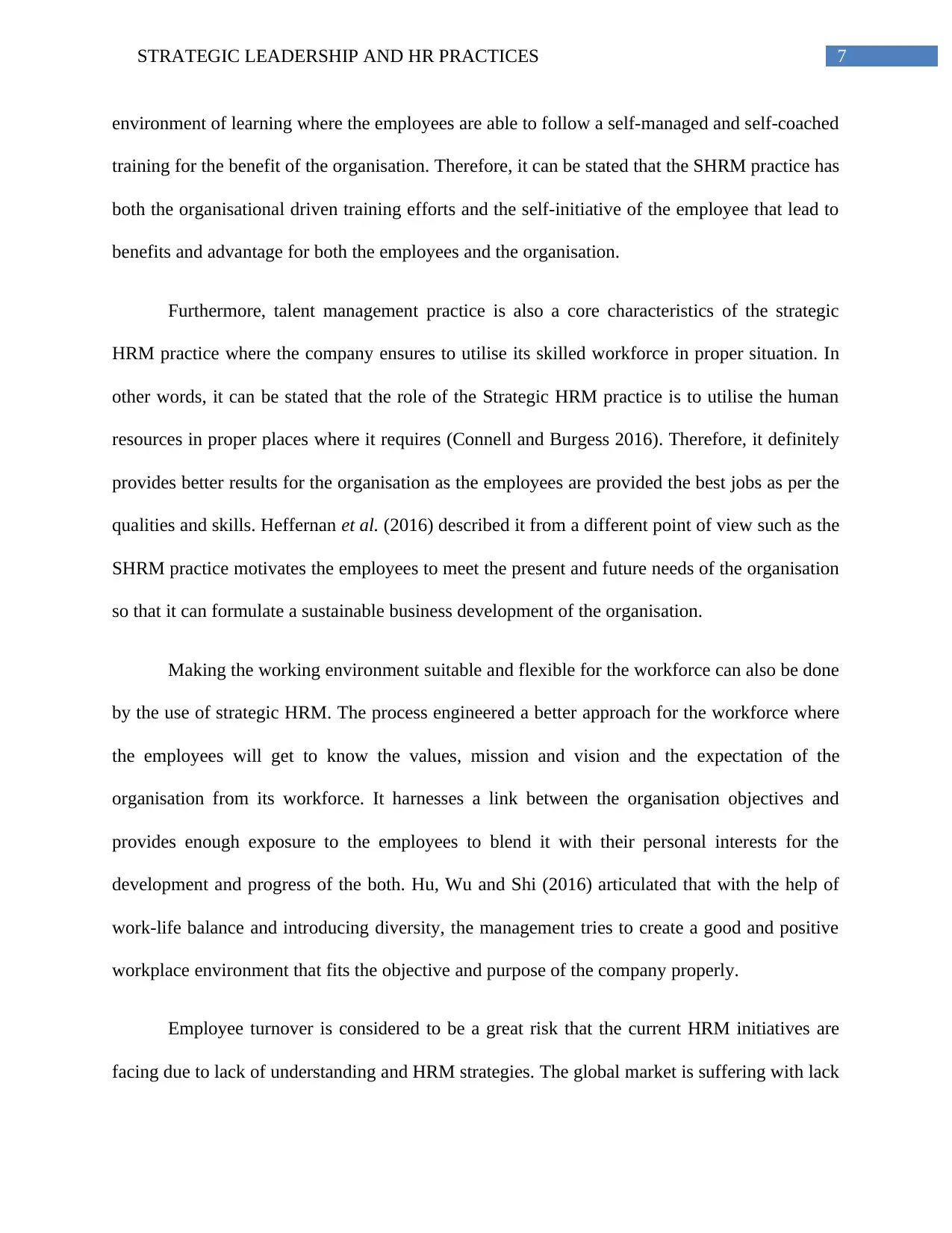
7STRATEGIC LEADERSHIP AND HR PRACTICES
environment of learning where the employees are able to follow a self-managed and self-coached
training for the benefit of the organisation. Therefore, it can be stated that the SHRM practice has
both the organisational driven training efforts and the self-initiative of the employee that lead to
benefits and advantage for both the employees and the organisation.
Furthermore, talent management practice is also a core characteristics of the strategic
HRM practice where the company ensures to utilise its skilled workforce in proper situation. In
other words, it can be stated that the role of the Strategic HRM practice is to utilise the human
resources in proper places where it requires (Connell and Burgess 2016). Therefore, it definitely
provides better results for the organisation as the employees are provided the best jobs as per the
qualities and skills. Heffernan et al. (2016) described it from a different point of view such as the
SHRM practice motivates the employees to meet the present and future needs of the organisation
so that it can formulate a sustainable business development of the organisation.
Making the working environment suitable and flexible for the workforce can also be done
by the use of strategic HRM. The process engineered a better approach for the workforce where
the employees will get to know the values, mission and vision and the expectation of the
organisation from its workforce. It harnesses a link between the organisation objectives and
provides enough exposure to the employees to blend it with their personal interests for the
development and progress of the both. Hu, Wu and Shi (2016) articulated that with the help of
work-life balance and introducing diversity, the management tries to create a good and positive
workplace environment that fits the objective and purpose of the company properly.
Employee turnover is considered to be a great risk that the current HRM initiatives are
facing due to lack of understanding and HRM strategies. The global market is suffering with lack
environment of learning where the employees are able to follow a self-managed and self-coached
training for the benefit of the organisation. Therefore, it can be stated that the SHRM practice has
both the organisational driven training efforts and the self-initiative of the employee that lead to
benefits and advantage for both the employees and the organisation.
Furthermore, talent management practice is also a core characteristics of the strategic
HRM practice where the company ensures to utilise its skilled workforce in proper situation. In
other words, it can be stated that the role of the Strategic HRM practice is to utilise the human
resources in proper places where it requires (Connell and Burgess 2016). Therefore, it definitely
provides better results for the organisation as the employees are provided the best jobs as per the
qualities and skills. Heffernan et al. (2016) described it from a different point of view such as the
SHRM practice motivates the employees to meet the present and future needs of the organisation
so that it can formulate a sustainable business development of the organisation.
Making the working environment suitable and flexible for the workforce can also be done
by the use of strategic HRM. The process engineered a better approach for the workforce where
the employees will get to know the values, mission and vision and the expectation of the
organisation from its workforce. It harnesses a link between the organisation objectives and
provides enough exposure to the employees to blend it with their personal interests for the
development and progress of the both. Hu, Wu and Shi (2016) articulated that with the help of
work-life balance and introducing diversity, the management tries to create a good and positive
workplace environment that fits the objective and purpose of the company properly.
Employee turnover is considered to be a great risk that the current HRM initiatives are
facing due to lack of understanding and HRM strategies. The global market is suffering with lack
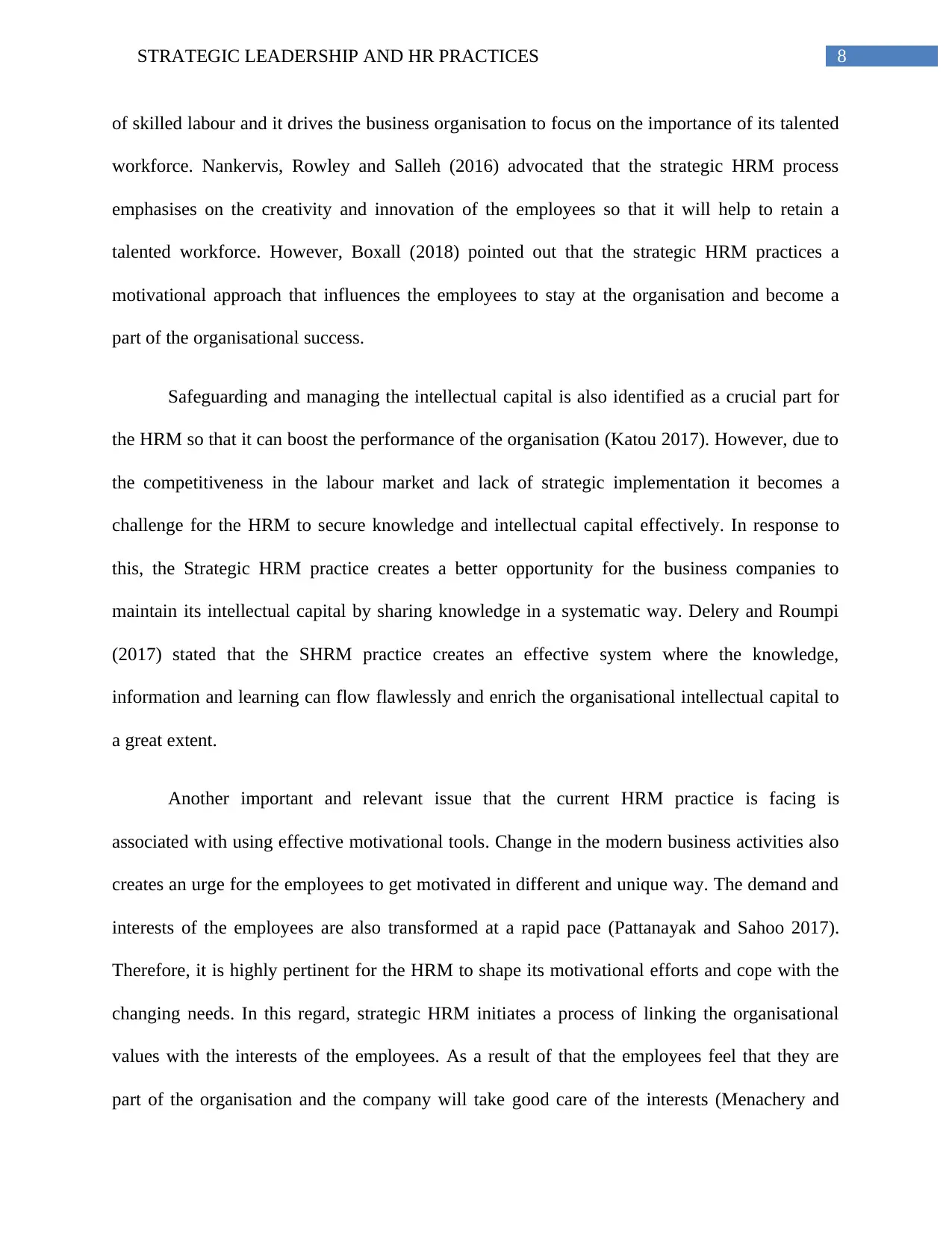
8STRATEGIC LEADERSHIP AND HR PRACTICES
of skilled labour and it drives the business organisation to focus on the importance of its talented
workforce. Nankervis, Rowley and Salleh (2016) advocated that the strategic HRM process
emphasises on the creativity and innovation of the employees so that it will help to retain a
talented workforce. However, Boxall (2018) pointed out that the strategic HRM practices a
motivational approach that influences the employees to stay at the organisation and become a
part of the organisational success.
Safeguarding and managing the intellectual capital is also identified as a crucial part for
the HRM so that it can boost the performance of the organisation (Katou 2017). However, due to
the competitiveness in the labour market and lack of strategic implementation it becomes a
challenge for the HRM to secure knowledge and intellectual capital effectively. In response to
this, the Strategic HRM practice creates a better opportunity for the business companies to
maintain its intellectual capital by sharing knowledge in a systematic way. Delery and Roumpi
(2017) stated that the SHRM practice creates an effective system where the knowledge,
information and learning can flow flawlessly and enrich the organisational intellectual capital to
a great extent.
Another important and relevant issue that the current HRM practice is facing is
associated with using effective motivational tools. Change in the modern business activities also
creates an urge for the employees to get motivated in different and unique way. The demand and
interests of the employees are also transformed at a rapid pace (Pattanayak and Sahoo 2017).
Therefore, it is highly pertinent for the HRM to shape its motivational efforts and cope with the
changing needs. In this regard, strategic HRM initiates a process of linking the organisational
values with the interests of the employees. As a result of that the employees feel that they are
part of the organisation and the company will take good care of the interests (Menachery and
of skilled labour and it drives the business organisation to focus on the importance of its talented
workforce. Nankervis, Rowley and Salleh (2016) advocated that the strategic HRM process
emphasises on the creativity and innovation of the employees so that it will help to retain a
talented workforce. However, Boxall (2018) pointed out that the strategic HRM practices a
motivational approach that influences the employees to stay at the organisation and become a
part of the organisational success.
Safeguarding and managing the intellectual capital is also identified as a crucial part for
the HRM so that it can boost the performance of the organisation (Katou 2017). However, due to
the competitiveness in the labour market and lack of strategic implementation it becomes a
challenge for the HRM to secure knowledge and intellectual capital effectively. In response to
this, the Strategic HRM practice creates a better opportunity for the business companies to
maintain its intellectual capital by sharing knowledge in a systematic way. Delery and Roumpi
(2017) stated that the SHRM practice creates an effective system where the knowledge,
information and learning can flow flawlessly and enrich the organisational intellectual capital to
a great extent.
Another important and relevant issue that the current HRM practice is facing is
associated with using effective motivational tools. Change in the modern business activities also
creates an urge for the employees to get motivated in different and unique way. The demand and
interests of the employees are also transformed at a rapid pace (Pattanayak and Sahoo 2017).
Therefore, it is highly pertinent for the HRM to shape its motivational efforts and cope with the
changing needs. In this regard, strategic HRM initiates a process of linking the organisational
values with the interests of the employees. As a result of that the employees feel that they are
part of the organisation and the company will take good care of the interests (Menachery and
⊘ This is a preview!⊘
Do you want full access?
Subscribe today to unlock all pages.

Trusted by 1+ million students worldwide
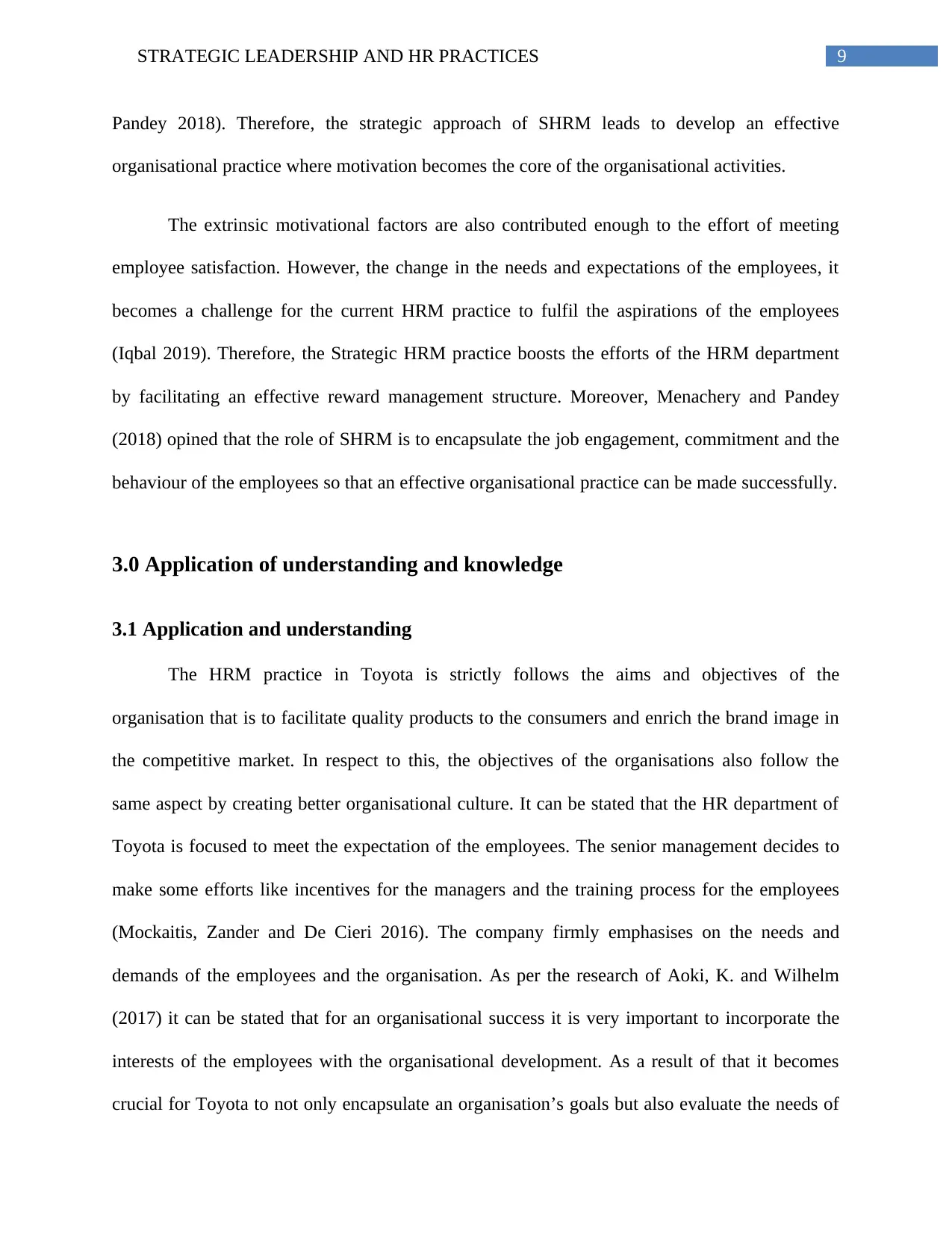
9STRATEGIC LEADERSHIP AND HR PRACTICES
Pandey 2018). Therefore, the strategic approach of SHRM leads to develop an effective
organisational practice where motivation becomes the core of the organisational activities.
The extrinsic motivational factors are also contributed enough to the effort of meeting
employee satisfaction. However, the change in the needs and expectations of the employees, it
becomes a challenge for the current HRM practice to fulfil the aspirations of the employees
(Iqbal 2019). Therefore, the Strategic HRM practice boosts the efforts of the HRM department
by facilitating an effective reward management structure. Moreover, Menachery and Pandey
(2018) opined that the role of SHRM is to encapsulate the job engagement, commitment and the
behaviour of the employees so that an effective organisational practice can be made successfully.
3.0 Application of understanding and knowledge
3.1 Application and understanding
The HRM practice in Toyota is strictly follows the aims and objectives of the
organisation that is to facilitate quality products to the consumers and enrich the brand image in
the competitive market. In respect to this, the objectives of the organisations also follow the
same aspect by creating better organisational culture. It can be stated that the HR department of
Toyota is focused to meet the expectation of the employees. The senior management decides to
make some efforts like incentives for the managers and the training process for the employees
(Mockaitis, Zander and De Cieri 2016). The company firmly emphasises on the needs and
demands of the employees and the organisation. As per the research of Aoki, K. and Wilhelm
(2017) it can be stated that for an organisational success it is very important to incorporate the
interests of the employees with the organisational development. As a result of that it becomes
crucial for Toyota to not only encapsulate an organisation’s goals but also evaluate the needs of
Pandey 2018). Therefore, the strategic approach of SHRM leads to develop an effective
organisational practice where motivation becomes the core of the organisational activities.
The extrinsic motivational factors are also contributed enough to the effort of meeting
employee satisfaction. However, the change in the needs and expectations of the employees, it
becomes a challenge for the current HRM practice to fulfil the aspirations of the employees
(Iqbal 2019). Therefore, the Strategic HRM practice boosts the efforts of the HRM department
by facilitating an effective reward management structure. Moreover, Menachery and Pandey
(2018) opined that the role of SHRM is to encapsulate the job engagement, commitment and the
behaviour of the employees so that an effective organisational practice can be made successfully.
3.0 Application of understanding and knowledge
3.1 Application and understanding
The HRM practice in Toyota is strictly follows the aims and objectives of the
organisation that is to facilitate quality products to the consumers and enrich the brand image in
the competitive market. In respect to this, the objectives of the organisations also follow the
same aspect by creating better organisational culture. It can be stated that the HR department of
Toyota is focused to meet the expectation of the employees. The senior management decides to
make some efforts like incentives for the managers and the training process for the employees
(Mockaitis, Zander and De Cieri 2016). The company firmly emphasises on the needs and
demands of the employees and the organisation. As per the research of Aoki, K. and Wilhelm
(2017) it can be stated that for an organisational success it is very important to incorporate the
interests of the employees with the organisational development. As a result of that it becomes
crucial for Toyota to not only encapsulate an organisation’s goals but also evaluate the needs of
Paraphrase This Document
Need a fresh take? Get an instant paraphrase of this document with our AI Paraphraser
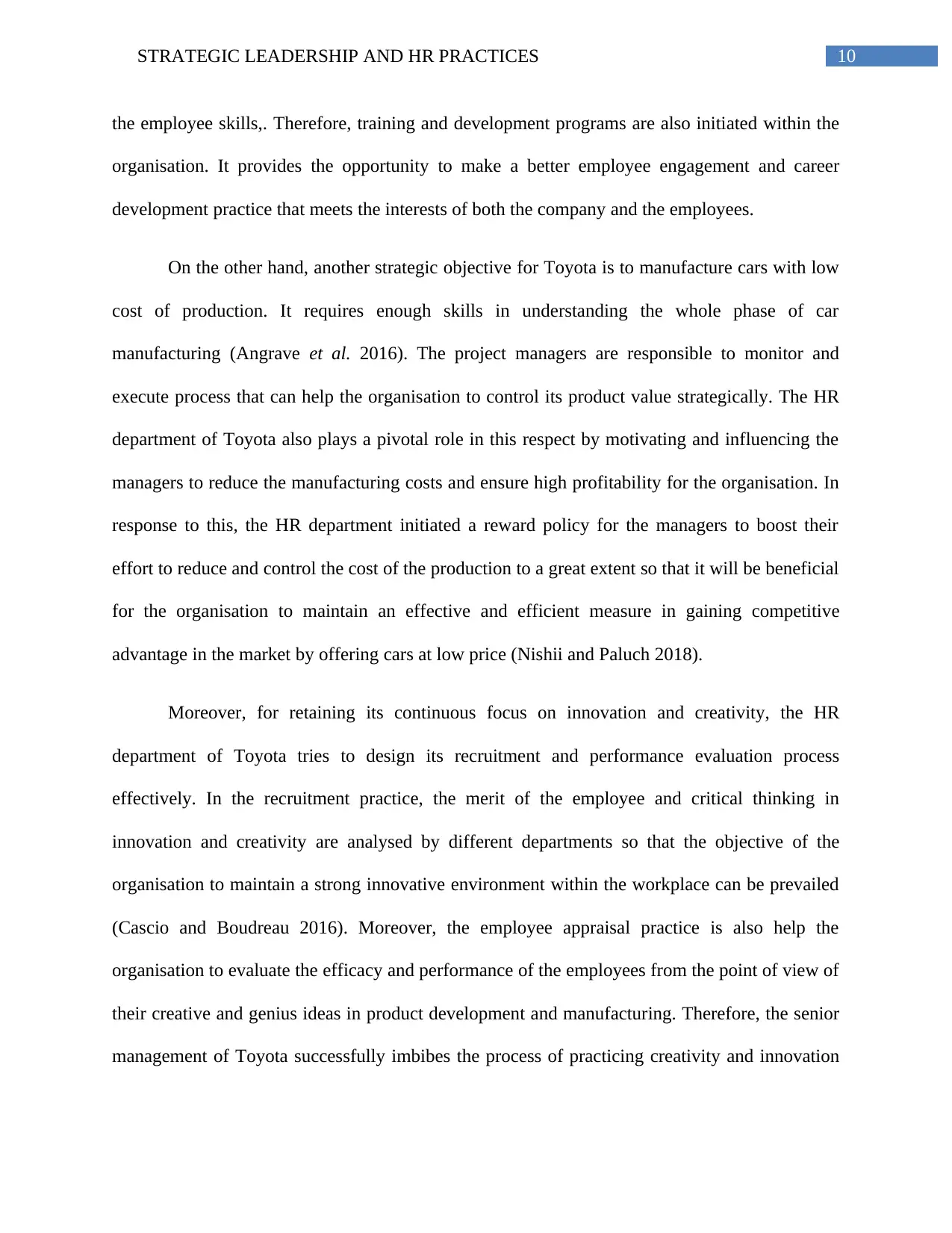
10STRATEGIC LEADERSHIP AND HR PRACTICES
the employee skills,. Therefore, training and development programs are also initiated within the
organisation. It provides the opportunity to make a better employee engagement and career
development practice that meets the interests of both the company and the employees.
On the other hand, another strategic objective for Toyota is to manufacture cars with low
cost of production. It requires enough skills in understanding the whole phase of car
manufacturing (Angrave et al. 2016). The project managers are responsible to monitor and
execute process that can help the organisation to control its product value strategically. The HR
department of Toyota also plays a pivotal role in this respect by motivating and influencing the
managers to reduce the manufacturing costs and ensure high profitability for the organisation. In
response to this, the HR department initiated a reward policy for the managers to boost their
effort to reduce and control the cost of the production to a great extent so that it will be beneficial
for the organisation to maintain an effective and efficient measure in gaining competitive
advantage in the market by offering cars at low price (Nishii and Paluch 2018).
Moreover, for retaining its continuous focus on innovation and creativity, the HR
department of Toyota tries to design its recruitment and performance evaluation process
effectively. In the recruitment practice, the merit of the employee and critical thinking in
innovation and creativity are analysed by different departments so that the objective of the
organisation to maintain a strong innovative environment within the workplace can be prevailed
(Cascio and Boudreau 2016). Moreover, the employee appraisal practice is also help the
organisation to evaluate the efficacy and performance of the employees from the point of view of
their creative and genius ideas in product development and manufacturing. Therefore, the senior
management of Toyota successfully imbibes the process of practicing creativity and innovation
the employee skills,. Therefore, training and development programs are also initiated within the
organisation. It provides the opportunity to make a better employee engagement and career
development practice that meets the interests of both the company and the employees.
On the other hand, another strategic objective for Toyota is to manufacture cars with low
cost of production. It requires enough skills in understanding the whole phase of car
manufacturing (Angrave et al. 2016). The project managers are responsible to monitor and
execute process that can help the organisation to control its product value strategically. The HR
department of Toyota also plays a pivotal role in this respect by motivating and influencing the
managers to reduce the manufacturing costs and ensure high profitability for the organisation. In
response to this, the HR department initiated a reward policy for the managers to boost their
effort to reduce and control the cost of the production to a great extent so that it will be beneficial
for the organisation to maintain an effective and efficient measure in gaining competitive
advantage in the market by offering cars at low price (Nishii and Paluch 2018).
Moreover, for retaining its continuous focus on innovation and creativity, the HR
department of Toyota tries to design its recruitment and performance evaluation process
effectively. In the recruitment practice, the merit of the employee and critical thinking in
innovation and creativity are analysed by different departments so that the objective of the
organisation to maintain a strong innovative environment within the workplace can be prevailed
(Cascio and Boudreau 2016). Moreover, the employee appraisal practice is also help the
organisation to evaluate the efficacy and performance of the employees from the point of view of
their creative and genius ideas in product development and manufacturing. Therefore, the senior
management of Toyota successfully imbibes the process of practicing creativity and innovation
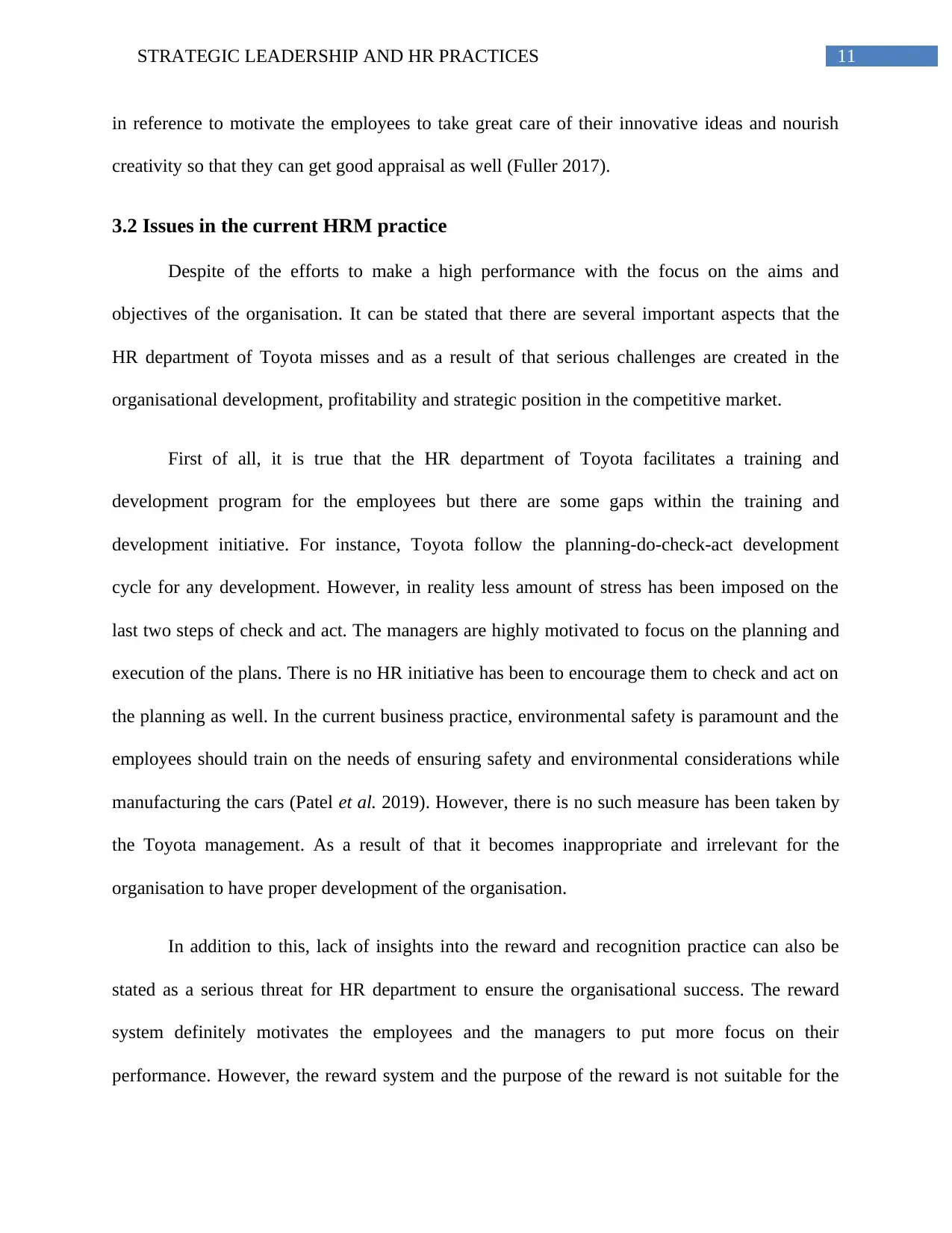
11STRATEGIC LEADERSHIP AND HR PRACTICES
in reference to motivate the employees to take great care of their innovative ideas and nourish
creativity so that they can get good appraisal as well (Fuller 2017).
3.2 Issues in the current HRM practice
Despite of the efforts to make a high performance with the focus on the aims and
objectives of the organisation. It can be stated that there are several important aspects that the
HR department of Toyota misses and as a result of that serious challenges are created in the
organisational development, profitability and strategic position in the competitive market.
First of all, it is true that the HR department of Toyota facilitates a training and
development program for the employees but there are some gaps within the training and
development initiative. For instance, Toyota follow the planning-do-check-act development
cycle for any development. However, in reality less amount of stress has been imposed on the
last two steps of check and act. The managers are highly motivated to focus on the planning and
execution of the plans. There is no HR initiative has been to encourage them to check and act on
the planning as well. In the current business practice, environmental safety is paramount and the
employees should train on the needs of ensuring safety and environmental considerations while
manufacturing the cars (Patel et al. 2019). However, there is no such measure has been taken by
the Toyota management. As a result of that it becomes inappropriate and irrelevant for the
organisation to have proper development of the organisation.
In addition to this, lack of insights into the reward and recognition practice can also be
stated as a serious threat for HR department to ensure the organisational success. The reward
system definitely motivates the employees and the managers to put more focus on their
performance. However, the reward system and the purpose of the reward is not suitable for the
in reference to motivate the employees to take great care of their innovative ideas and nourish
creativity so that they can get good appraisal as well (Fuller 2017).
3.2 Issues in the current HRM practice
Despite of the efforts to make a high performance with the focus on the aims and
objectives of the organisation. It can be stated that there are several important aspects that the
HR department of Toyota misses and as a result of that serious challenges are created in the
organisational development, profitability and strategic position in the competitive market.
First of all, it is true that the HR department of Toyota facilitates a training and
development program for the employees but there are some gaps within the training and
development initiative. For instance, Toyota follow the planning-do-check-act development
cycle for any development. However, in reality less amount of stress has been imposed on the
last two steps of check and act. The managers are highly motivated to focus on the planning and
execution of the plans. There is no HR initiative has been to encourage them to check and act on
the planning as well. In the current business practice, environmental safety is paramount and the
employees should train on the needs of ensuring safety and environmental considerations while
manufacturing the cars (Patel et al. 2019). However, there is no such measure has been taken by
the Toyota management. As a result of that it becomes inappropriate and irrelevant for the
organisation to have proper development of the organisation.
In addition to this, lack of insights into the reward and recognition practice can also be
stated as a serious threat for HR department to ensure the organisational success. The reward
system definitely motivates the employees and the managers to put more focus on their
performance. However, the reward system and the purpose of the reward is not suitable for the
⊘ This is a preview!⊘
Do you want full access?
Subscribe today to unlock all pages.

Trusted by 1+ million students worldwide
1 out of 33
Related Documents
Your All-in-One AI-Powered Toolkit for Academic Success.
+13062052269
info@desklib.com
Available 24*7 on WhatsApp / Email
![[object Object]](/_next/static/media/star-bottom.7253800d.svg)
Unlock your academic potential
Copyright © 2020–2025 A2Z Services. All Rights Reserved. Developed and managed by ZUCOL.




